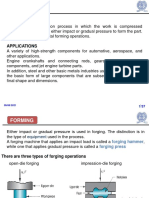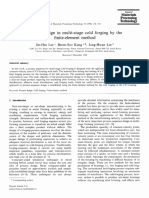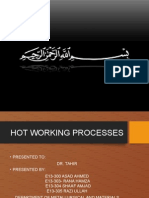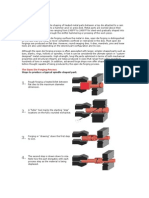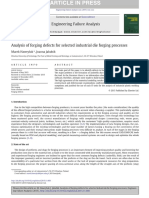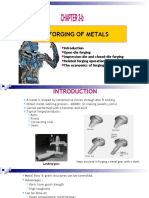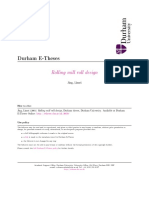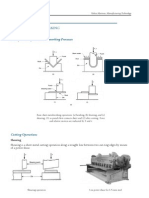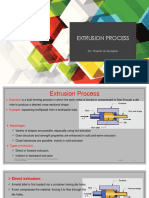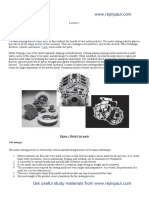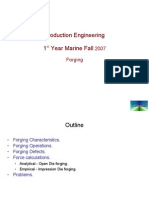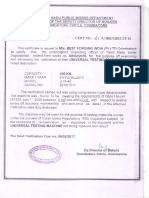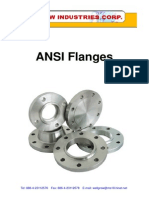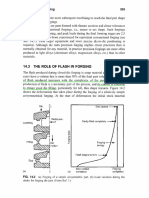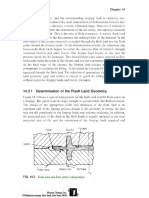0 ratings0% found this document useful (0 votes) 431 views7 pagesRoll Forging Process
Copyright
© © All Rights Reserved
We take content rights seriously. If you suspect this is your content,
claim it here.
Available Formats
Download as PDF or read online on Scribd
protection may or may not be necessary, depending on the noise level in the shop. The need for aprons, spats, leggings,
and sleeves depends on the hazards to which the operator is exposed,
With the exception of the feed area, the entire upsetter should be heavily guarded. Provision should be made such that the
access doors (0 the upsetter must be closed before it can be operated. A guard over the operating pedal and a pedal lock
will minimize accidental tripping of the upsetter. All loose articles should be removed from the top of the upsetter to
prevent them from falling from or into the machine,
At no time should the operator put his hands or arms between the dies of the upsetter. Lubricating swabs or scale
removers should have handles that are long enough to permit the operator to reach the full length of the dies without
putting his hands between the dies. Before an operator makes an adjustment fo any of the tools or dies, the power should
be locked off, the flywheel should be completely stopped, and the air, water, and oil lines should be shut off, All power
switches and valves should be identified and should be located where they can be easily reached by the operator. In
handling heavy tools, lifting equipment is needed; the operator should use care to avoid injury when changing tools,
When gripper dies are used, it is important that the dies hold the forging in place. Although the use of backstops is
recommended where practical, they should not be employed to offset insufficient gripping. Gages should locate the part
‘with minimum hazard to the operator. For heavy forgings, properly maintained balancing equipment will reduce operator
fatigue.
A preventive maintenance program is needed to keep upsetters in safe operating condition. In addition to making a daily
check of tools, belts, pulleys, lines, gages, and valves, the operator should report any change in the performance of the
upsetter when it is first observed. Handling equipment should be checked before it is used and should be thoroughly
inspected on a regular basis. Daily lubrication is needed on machines that are not equipped with automatic lubrication, Air
clutches and brakes should be checked daily, and moving parts should be checked and adjusted weekly.
‘An important consideration with regard to safety in hot upset forging is the selection of proper die material and die
hardness, This is discussed in the article "Dies and Die Materials for Hot Forging” in this Volume.
Roll Forging
Introduc!
n
ROLL FORGING (also known as hot forge rolling) is a process for reducing the cross-sectional area of heated bars or
billets by passing them between two driven rolls that rotate in opposite directions and have one or more matching grooves
in cach roll. The principle involved in reducing the cross-sectional area of the work metal in roll forging is essentially the
same as that employed in rolling mills to reduce billets to bars,
Applications
Any metal that can be forged by other methods can be roll forged. Heating times and temperatures are the same as those
used in the forging of metals in open or closed dies. See the articles "Closed-Die Forging in Hammers and Presses” and
"Hot Upset Forging," as well as the articles on the forging of specific metals, in this Volume.
Roll forging serves two general areas of application:
+ As the sole operation, or as the main operation, in producing a shape
+ Asa preliminary operation to save material and number of hits in subsequent forging in closed dies
Applications in the first category above generally involve the shaping of long, thin, usually tapered parts. Typical
examples are airplane propeller-blade half sections, tapered axle shafts, tapered leaf springs, table-knife blades, barge
nails, hand shovels and spades, various agricultural tools (such as pitchforks), and tradesman’s tools (such as chisels andl
trowels). Roll forging is sometimes followed by the upsetting of one end of the workpiece to form a flange, as in the
forging of axle shat.�Applications in the second category above include preliminary shaping of stock prior to forging in closed dies in either a
press or hammer, thus eliminating a fullering or blocking operation. Crankshafls, connecting rods, and other automotive
pparts are typical products that are first roll forged from billets to preform stock, and then finish forged in a press.
Roll Forging
Machines
Machines for roll forging (often called forge rolls, reducer rolls, back rolls, or gap rolls) are of two general types (Fig. 1
and 2). In both types, the driving motor is mounted at the top of the main housing. The motor drives a large flywheel by
‘means of V-belts, In turn, the flywheol drives the roll shafls, to which the roll dies are attached, through a system of gears.
Outboard
housing
Fig. 1 Roll-forging machine with outboard housing,�Tobie:
Fig. 2 Overhang-type roll-forging machine.
‘The machine shown in Fig. 1 has an outboard housing, which supports the roll shafts at both ends. On this machine, the
shafis extend through the housing, thus permitting an additional pair of roll dies to be mounted on the shafts. On some
‘machines of this type, the roll shafts extend only into the outboard housing; this permits the use of only one set of roll
dies. Various sizes ofthis type of machine, ranging from 3.7 1 220 kW (5 to 300 hp, will eeommodate roll des 318 10
1120 mm (122 to 44 in.) in diameter and 356 to 1520 mm (14 to 60 in.) wide.
‘The machine illustrated in Fig. 2 is generally known as the overhang type because it has no outboard housing 0 support
the roll shafis, Otherwise, the significant components of this machine are similar to those of the machine illustrated in Fig.
1, Depending on size, these machines are equipped with 15 to 75 kW (20 to 100 hp) motors and will accommodate roll
dies 305 to 559 mm (12 to 22 in.) in diameter and 178 to 457 mm (7 to 18 in.) wide.
Selection. The outboard-housing type of machine (Fig. 1) is ordinarily used when roll forging is the sole or the main
operation for producing a shape and when close tolerances are required on the workpiece. The reason for the preference is
that this class of work generally requires wide roll dies with many grooves (sometimes as many as 12 or mote, but usually
‘fewer than 8), Ifroll dies are exiremely wide in relation to their diameter, lack of rigidity is a problem.
The overhang-type machine (Fig. 2) is most often used for the rol forging of stock in preparation for closed-die forging
or up-setting. For this type of work, relatively narrow roll dies with two to four grooves are generally used. Therefore,
lack of rigidity caused by excessive overhang is not a problem, and better accessibility is gained by the absence of the
outboard housing. In addition, the fully cylindrical roll dies used in this type of machine offer more periphery for roll
forging.
Selection of machine size depends mainly on the following considerations:
+ Power must be adequate to reduce the forging stock
+ Rigidity must be sufficient to maintain dimensional accuracy. Adequate rigidity is especially important
when rolling to thin, wide wedge shapes
+ Roll shafts must be long enough (overhang or distance between housings) to accommodate roll dies that,�are wide enough to contain the entire series of grooves required to accomplish the cross-sectional
reduction. The width of the roll dies ean sometimes be reduced by using the first-reduction grooves for
‘wo or more passes or by inching the workpiece forward in the tapered grooves
Distance between centers of roll shafts must be sufficient to accommodate roll dies large enough in
iameter to roll the full length of the reduced section of the workpiece, so that the taper will not have to
be overlapped in adjacent grooves of the roll dies
Forging rolls are available in numerous sizes and have the capacity to roll blanks up to 127 mm (5 in.) thick and 1020 mm_
(40 in,) tong,
Operation. Roll dies designed for forging the required shape are bolted to the roll shafts, which rotate in opposite
directions during operation. Roll dies (or their effective forging portion) usually occupy about one-half the total
circumference; therefore, atleast some forging action takes place during half of the revolution,
Machines can be operated continuously or stopped between passes, as required, In the roll forging of long tapered
workpieces, the more common practice is to operate the machine intermittently, using the following technique (Fig. 3)
5, and starts
The operator lays the heated stock on the table of the machine, grasps the stock with ton;
the machine (commonly controlled by a foot treadle)
During the portion of the revolution when the roll dies are in the open position, the operator places the
stock between them against a stock gage and in line with the first roll groove, retaining his tong hold on
the workpiece. The tables are usually grooved to assist in aligning the stock
As the roll dies rotate to the closed position, forging begins, The workpicce is forced back toward the
operator, who moves it to the position of the next roll-die groove and again pushes it against the stop
during the open position of the roll dies. This is repeated until the workpiece has been forged through
the entire series of grooves
In a few mass-production applications, the roll-forging procedure described above has been automated, but manual
operation is by far the most common practice.
Fig. 3 Schematic of roll-forging operation using multiple passes.
When side squeezing between roll passes is desirable for such operations as the pointing of springs or the tapering of
chisel blades, the machine can be designed t0 incorporate a horizontal front press close to the rolls. For shearing,
trimming, straightening, and bending, a vertical side press can be built into the main housing. Both of these auxiliary
presses are of the simple eccentric type, driven from a roll shat�When roll forging is used to preform stock prior to completing in dies, the machine is usually stopped after each roll pass,
parlly because fewer passes are used (often only one or two) and partly because continuous operation may be undesirable
for the companion forging operations. Some automation is usually applied to this type of roll-forging application;
therefore, little or no manual handling is required.
Roll Forging
Roll Dies
Roll dies are of three types: flat back, semicylindrical, and fully cylindrical (Fig. 4),
Fig. 4 Three types of dies used in roll forging.
Flat-back dies are primarily used for short-length reduetions. They are bolted to the roll shafts and can be easily
changed. Typical contours fora set of flat-back segmental dies are shown in Fig. 5.
Fig. 5 Contours in a typical set of flat-back segmental dies used to forge the workpiece illustrated.
Semicylindrical dies arc well suited to the forging of medium-length workpieces. Most are true half-eylinders (180°),
although some (particularly in large sizes) may encompass up to 220° of a circle to provide sufficient periphery for the
specific application, When cach die section is no more than 180°, the dies can be made by first machining the flat surfaces
of the half-rounds for assembly, clamping the half-rounds together, and then boring and finishing.
Example 1: Forging of an Axle Shaft in Ten Passes Through Eight-Groove Semi-
Cylindrical Roll Dies.
‘An axle shaft was roll forged from a 1037 steel blank in ten passes through cight-groove semicylindrical roll dics, as
shown in Fig. 6, After each successive pass, the workpiece was rotated 90°, The shaft was forged in a 30 kW (40 hp)
‘machine with an outboard housing; the eight-groove dies were 635 mm (24 in.) wide. The roll shafts were rotated at
40 spm. In continuous operation, one operator rolled approximately 180 shafls per hour.�: ae®
= FAD)
ee ee So en foe G . bs
= nee
Fig. 6 Forging of an axle shaft in ten passes through eight-groove semicylindrical roll dies. Dimensions given in
inches.
After it was roll forged, the shaft was straightened by hot coining and was sheared without being reheated. The large end
was then reheated and was flanged in an upsetter.
Fully cylindrical dies are used for the forging of long members, sometimes in an overhang-type machine. ‘They are
‘made most economically by being built up with rings, with a cutaway portion just large enough to feed in the forging
stock. Fully cylindrical dies are sometimes more efficient than semicylindrical or flat-back dies because of the larger�periphery available for the forging action. However, one disadvantage of fully cylindrical dies is that the opening is too
small to permit continuous operation; consequently, these dies require control of motion by a clutch and a brake.
Material. Stecls used for rll dies do not differ greatly from those used for dies in hammer, press, and upset forging (see
the articles "Closed-Die Forging in Hammers and Presses” and "Hot Upset Forging” in this Volume). However, because
roll dies are subjected (o ess impact than dies in other types of forging, they can be made of die steels that are somewhat
higher in carbon content—which is helpftl in prolonging die life, The following composition is typical for roll dies
Element | Composition, %
© 0.70-0.80
win | o.600.80
si 030040
ce | oss
Mo | 030-0.38
Dies can be made from wrought material or from castings.
Hardness of roll dies is likely to vary considerably, depending largely on whether or not changes in die design are
anticipated. When the die design is not subject to change, a hardness range of $0 t0 $5 HRC is common. Although this
range is higher than ean be tolerated in most hammer or press forging, it is permissible in roll forging because the dies are
subjected to less impact, which helps to prolong die lite
‘When dies are subject to design changes, common practice is to keep hardness below the maximum that is practical to
‘machine. Under these conditions, 45 HRC is the approximate maximum, and a range of 35 to 40 HRC is more common,
Die life depends mainly on die hardness, severity (depth of the grooves or other configurations in the dies), whether or
‘ot flash is permitted, and work metal composition. Die hardness has a major influence on die life. Dies hardened to 50 to
55 HRC have often had a total life of 190,000 to 200,000 pieces in the no-flash roll forging of low-carbon steel to simple
shapes (severity no greater than that of the workpiece described in Example 1). In similar applications, however, dies of
the same materials at 35 to 40 HRC have had a total life of only 30,000 pieces.
As severity increases, die life will decrease, to a degree generally parallel to that experienced with similar changes of
severity in hammer and press forging (see the article "Dies and Die Materials for Hot Forging" in this Volume). If any
flash is formed and not allowed for in die design, the dies will be overstressed and their life shortened. Although litle
significant difference in die life can be attributed to variations in composition among the carbon and alloy steels that are
‘most commonly roll forged, die life does decrease as the hot strength of the work metal increases, as with other types of
forging dies.








